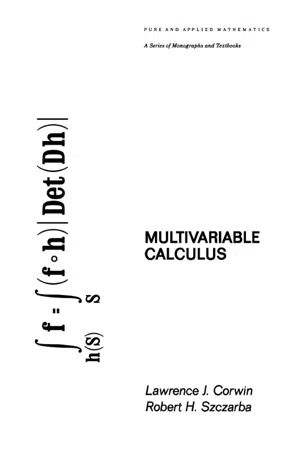Mathematics
Inverse functions
Inverse functions are pairs of functions that "undo" each other. If a function f(x) maps an input x to an output y, its inverse function, denoted as f^-1(y), maps y back to x. In other words, the inverse function reverses the action of the original function, allowing us to retrieve the original input from the output.
Written by Perlego with AI-assistance
Related key terms
Related key terms
1 of 4
Related key terms
1 of 3
5 Key excerpts on "Inverse functions"
- eBook - ePub
Making Sense of Mathematics for Teaching High School
Understanding How to Use Functions
- Edward C. Nolan, Juli K. Dixon, Farhsid Safi, Erhan Selcuk Haciomeroglu(Authors)
- 2016(Publication Date)
- Solution Tree Press(Publisher)
In reflecting across the line y = x, you are transforming points from being a certain distance from the origin relative to the x -axis to be that same distance from the origin but now relative to the y -axis. You are transforming the coordinates of all points of a given function (x, y) to correspond to the points of the inverse of the function (y, x). Consider the graph of the pre-image of f (x) = x 2 and reflected image (see figure 4.13). Figure 4.13: Symmetry of a quadratic and a square root function. Squaring a number (and because of the restricted domain, a positive number) and then taking the square root returns the value of the original number, one “undoes” the other. In mathematics, functions that operate in this manner are inverses to one another. Recall the discussion of inverses from chapter 1 (page 28). Composing these two functions—placing one function within the other—yields. In other words, applying one function, g (x), directly followed by the next function, f (x), returns the original input value, x. Conversely. Therefore, even if you were to compose these two functions in the reverse order, you would still undo the impact and get the original value of x. This idea of symmetry—both about the line y = x and in the composition of functions—assists in thinking about inverses beyond just exploring the connection between quadratic and square root functions. How could this work in context? You can engage in attaching mathematical meaning to the word inverse where you invert the role and location of x and y. Imagine having the revenue function R (x) = −20 p 2 + 1000 p, where R (x) is the revenue generated at a particular product price p. With the given function, you are able to determine the revenue from a given unit price. You may also want to determine a particular product price that would generate revenue. In this example, you might want to determine a product price to generate revenue of $20,000 or $40,000 - eBook - ePub
- L. Corwin(Author)
- 2017(Publication Date)
- CRC Press(Publisher)
9The Inverse and Implicit Function TheoremsWe have seen (Chapter 4 ) that the derivative of a function at a point provides a good linear approximation to the function near the point. This fact suggests that properties of the derivative at a point should be reflected in properties of the function near the point. The inverse function theorem and implicit function theorem are both instances of this phenomenon. The inverse function theorem states that, if the derivative of a function f : R n → R n is invertible at v 0 , then so is f , at least near v 0 . The implicit function theorem gives conditions (on the Jacobian of a function) under which a collection of equations can be solved for some of the variables in terms of the rest. We note that the implicit function theorem is exactly what is needed to complete the discussion of constrained maxima and minima of the previous chapter.Both these theorems are quite important in mathematics, and the reader should, at the least, learn what they say. The proofs, however, are quite difficult, and the reader may wish to skip them on first reading.1. Inverse functions
Before we can state an inverse function theorem, we need to know what an inverse function is. Let U and V be open subsets of R n , and let f : U → V be a function. We say that a function g : V → U is an inverse for f if (g ∘ f ) (v ) = v for all v ∈ U and (f ∘ g ) (w ) = w for all w ∈ V . Clearly g is an inverse for f if and only if f is an inverse for g . It is also immediate that f : U → V has an inverse if and only if f is bijective (that is, both 1 − 1 and onto); see Exercise 1.For example, the function f : (0, 1) → (0, 1) given by f (x ) = x 2 has an inversegsince( y )= yand( g ∘ f )( x )= g(=x 2)x 2= x( f ∘ g )( y )= f( y )=( y= y) 2However, the function h : (— 1,1) → (0,1) defined by h (x ) = x 2 does not have an inverse since h is not injective: if k is an inverse, thenkand(= k1 4)( h (=1 2) )1 2k. Thus we have two values for(= k1 4)( h ( -= -1 2) )1 2k(1 4) - No longer available |Learn more
- Mary Jane Sterling(Author)
- 2014(Publication Date)
- For Dummies(Publisher)
Part IVEquations and Applications
Find the geometric properties that are most used when studying trigonometry in a free article at www.dummies.com/extras/trigonometry .In this part…- Become acquainted with inverse trig functions.
- Identify the domains and ranges of the inverse trig functions.
- Recognize the pairings of the quadrants used by each inverse function.
- Solve trig equations using identities and Inverse functions.
- Write expressions to include infinitely many answers.
- Find the areas of triangles using trig functions in the formulas.
Passage contains an image
Chapter 15Investigating Inverse Trig Functions
In This ChapterAcquainting yourself with inverse notationSetting limits on inverse trig functionsDetermining domain and range of inverse trig functionsA s thrilling and fulfilling as the original six trig functions are, they just aren't complete without their inverses. An inverse trig function behaves like the inverse of any other type of function — it undoes what the original function did. In mathematics, functions can have inverses if they're one-to-one, meaning each output value occurs only once. This whole inverse idea is going to take some fast talking when it comes to trig functions, because they keep repeating values over and over as angles are formed with every full rotation of the circle — so you're going to wonder how these functions and inverses can be one-to-one. If you need a refresher on basic Inverse functions, flip on back to Chapter 3 for the lowdown on them and how you determine one.Writing It Right
You use inverse trig functions to solve equations such asor sec x = –2, or tan 2x = 1. In typical algebra equations, you can solve for the value of x by dividing each side of the equation by the coefficient or by adding the same thing to each side, and so on. But you can't do that with the function .Would it make sense to divide each side by sine? “Out, out thou sine!” Here's what you'd get: - eBook - ePub
Proofs 101
An Introduction to Formal Mathematics
- Joseph Kirtland(Author)
- 2020(Publication Date)
- Chapman and Hall/CRC(Publisher)
Given that a function is a relation, we can compute the inverse of a function. Example 6.5.1. Consider the sets A = { 1, 2,3,4 }, B = { a, b, c }, C = { a, b, c, d }, and D = { a, b, c, d, e } Define the. function f : A → B by f = { (1, a), (2, a), (3, b), (,4, c) }. The inverse f − 1 from B to A is the relation f − 1 = { (a, 1), (a, 2), (b, 3), (c, 4) }. The function f and the relation f − 1 are visualized in Figure 6.4. Figure 6.4 Function f and its inverse from Example 6.5.1. The diagram shows that while f is a function, its inverse is not as f − 1 relates a in B to two different elements in A. The first lesson is that the inverse of a function may not be a function. Here, this is due to the fact that f is not one-to-one. Given that f (1) = f (2) = a, the inverse relation f − 1 relates a to both 1 and 2. Define the function g : A → D by g = { (1, b), (2, a), (3, d), (4, e) }. The inverse g − 1 from D to A is the relation g − 1 = { (b, 1), (a, 2), (d, 3), (e, 4) }. The function g and the relation g − 1 are visualized in Figure 6.4. Figure 6.5 Function g and its inverse from Example 6.5.1. The diagram shows that while g is a function, its inverse g − 1 is not as g − 1 does not relate the element c in D to any element in A. This is due to the fact that g is not onto. Given that c ∈ r a n (g), the inverse relation g − 1 does not relate c to any element in A. Define the function h : A → C by h = { (1, a), (2, d), (3, b), (4, c) }. The inverse h − 1 : C → A is the relation h − 1 = { (a, 1), (b, 3), (c, 4), (d, 2) }. The function h and the relation h − 1 are visualized in Figure 6.6. The function h is one-to-one and onto (a bijection), and note that h − 1 is also a function. Figure 6.6 Inverse of function h. The functions from Example 6.5.1 motivate the following result. Theorem 6.5.2. Let f : A → B be a function. The inverse relation f − 1 is a function if and only if f is a bijection. Proof. (⇒) Assume that f − 1 is a function. First we will show that f is one-to-one - eBook - ePub
- Bhavanari Satyanarayana, T.V. Pradeep Kumar, Shaik Mohiddin Shaw(Authors)
- 2019(Publication Date)
- CRC Press(Publisher)
−1 . Two functions f: A → B and g : C → D are said to be equal if A = C, B = D and f(a) = g(a) for all elements a in A = C. If two functions f and g are equal, then we write f = g.Theorem 3Let f: X → Y be a function and Ix is the identity function of X, then foIx = Ix of = f.Proof: Now foIx (x) = f(Ix (x)) = f(x). Similarly we get Ix of(x) = f(x).The identity function is one-one and onto. A function g is inverse of f ⇔ fog and gof are identity functions.Example 6.23Find out two functions f and g defined from R to R, where R is the set of all real numbers such that fog ≠ gof.Solution: Define f(x) = 2x and g(x) = x + 5 for all x in R.Then (fog)(1) = f(g(1)) = f(6) = 12This shows that the two functions are not equal at 1.( gof )( 1 )= g(= gf)( 1 )( 2 )= 2 + 5 = 7Example 6.24Prove that a function f has an inverse ⇔ f is one-one and onto.Solution: Suppose the inverse of f: S → T is g : T → S.By definition, gof(s) = s for all s in S and fog (t) = t for all t in T. To show f is one-one, suppose a, b ∈ S such that f(a) = f(b). By applying the function g on both sides, we get gof(a) = gof(b). Since gof is identity, we get a = gof(a) = gof(b) = b. Hence f is one-one. To show f is onto, let t be an element of T. Write x = g(t). Then x is in S and f(x) = f(g(t)) = fog(t) = t. Hence f is onto.Converse: Suppose f is one-one and onto.Define g : T → S as g(t) = s where f(s) = t. To verify that g is a function, suppose g(t) = a and g(t) = b. Then f(a) = t, f(b) = t. So f(a) = f(b) which implies a = b (since f is one-one). Therefore g is a function. For all s in S, we have that gof(s) = g(f(s)) = g(t) = s (where t = f(s)). Also for all t in T, we have fog(t) = f(g(t)) = f(s) = t. Hence g is an inverse of f.Note:Inverse of a function is unique. Identity function on a set is unique. Identity element in a set with respect to a binary operation is unique.6.3.2 Notation
Index pages curate the most relevant extracts from our library of academic textbooks. They’ve been created using an in-house natural language model (NLM), each adding context and meaning to key research topics.
Explore more topic indexes
Explore more topic indexes
1 of 6
Explore more topic indexes
1 of 4




